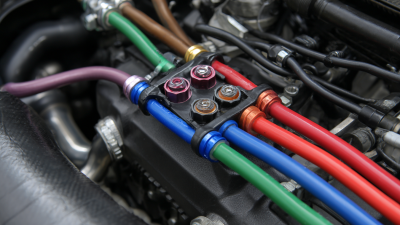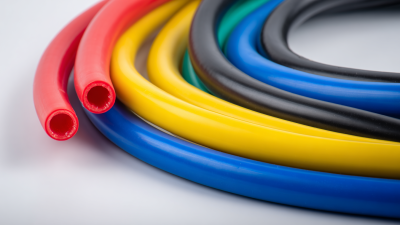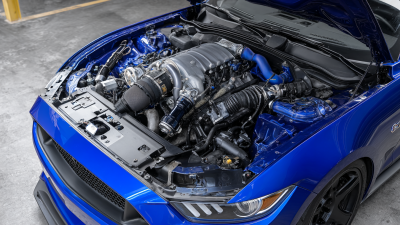In the world of automotive performance, the choice of components can dramatically influence the overall efficiency and power of a vehicle. Among these critical components, the Silicone Turbo Hose stands out as a vital link in turbocharged systems, responsible for withstanding high pressures and temperatures while ensuring optimal airflow. According to a recent report by the Specialty Equipment Market Association (SEMA), silicone hoses have gained popularity due to their superior durability and resistance to wear compared to traditional rubber hoses, with the aftermarket for silicone products projected to grow at a CAGR of 5.2% through 2026. As enthusiasts seek enhancements in vehicle performance, understanding the various types of silicone turbo hoses available can lead to significant improvements in power output and throttle response. This guide serves as an essential resource for selecting the right Silicone Turbo Hose, tailored to meet specific performance needs and ensure lasting reliability on the road.

When it comes to enhancing the performance of your vehicle's turbo system, selecting the right silicone turbo hose is crucial. These hoses are available in various types, each designed to meet specific performance needs and conditions. One common type is the standard silicone hose, which provides excellent durability and resistance to high temperatures, making it suitable for most applications. These hoses are often reinforced with fabrics to minimize expansion under pressure, ensuring consistent airflow and reliable performance.
Another option is the high-temperature silicone hose, which is designed to withstand extreme temperatures and harsh operating environments. These hoses are perfect for high-performance vehicles or setups that push the limits of standard silicone materials. Moreover, you can find specialized hoses with added features, such as braided designs for extra strength or varying diameters to optimize airflow in particular setups. Understanding these differences will help you make an informed decision, ensuring you choose a silicone turbo hose that meets both your performance and durability requirements.
When selecting the right silicone turbo hose for your vehicle, several key factors come into play to ensure optimal performance. First and foremost, you should consider the temperature and pressure ratings of the hose. High-quality silicone hoses should withstand extreme temperatures, often exceeding 200°C, and handle substantial pressure to maintain engine efficiency. Look for hoses that confirm their durability through rigorous testing and certification.
Additionally, the hose's diameter and length must align with your specific engine setup to prevent airflow restrictions, which can diminish turbo performance.
Furthermore, flexibility and compatibility are crucial. Silicone hoses should be pliable enough to accommodate various configurations without compromising integrity. Compatibility with your vehicle’s existing systems is also essential; ensure that the hose can easily connect to both the turbo and the intake system without leaks. By carefully examining these factors, you will not only enhance your vehicle’s performance but also extend the lifespan of your turbo system, making for a smoother and more efficient ride.
When selecting a silicone turbo hose, determining the right diameter and length is crucial for achieving optimal performance in your vehicle. The diameter of the hose significantly influences airflow; too small a diameter can restrict the airflow, leading to reduced power and efficiency. Conversely, an overly large diameter can result in turbulence, which may hinder the smooth flow of air into the engine. To find the correct diameter, it is essential to consider both the specifications of your turbo system and the intended performance goals of your vehicle.
Length also plays a pivotal role in the performance of your turbo hose. A shorter hose typically minimizes pressure drops and improves the response time of your turbo system. However, the length must be balanced with the need for flexibility and routing around engine components. Additionally, the path of the hose should be as direct as possible to prevent unnecessary bends, which can create resistance. By carefully assessing both the diameter and length of your silicone turbo hose, you can ensure enhanced airflow and, ultimately, a boost in your vehicle’s overall performance.
| Hose Diameter (mm) | Hose Length (mm) | Max Pressure (PSI) | Temperature Resistance (°C) | Material Grade |
|---|---|---|---|---|
| 25 | 100 | 30 | 200 | Standard |
| 32 | 150 | 35 | 220 | High Temp |
| 38 | 200 | 40 | 250 | Extreme |
| 45 | 300 | 30 | 180 | Standard |
| 51 | 400 | 50 | 230 | High Temp |
When selecting silicone turbo hoses, understanding temperature and pressure ratings is crucial for achieving optimal performance. According to industry standards, silicone hoses typically have a temperature range of -60°C to 200°C (-76°F to 392°F), allowing them to withstand a wide variety of operating conditions. This thermal resilience is essential in high-performance automotive applications where turbochargers can create extreme temperatures. A recent report by the Society of Automotive Engineers (SAE) indicates that using hoses that exceed their rated temperatures can lead to premature failure, reduced turbo efficiency, and even catastrophic engine damage.
Pressure ratings are equally important, as they determine the hose's ability to handle the forces generated by the turbo system. Most silicone turbo hoses are rated between 0.5 to 3 bar (7.25 to 43.5 psi), depending on their design and construction. A failure to select the appropriate hose that meets or exceeds the pressure requirements can result in leaks, reduced performance, and potential engine failures. According to a study published by the International Journal of Automotive Engineering, more than 65% of turbo-related issues stem from inadequate hose specifications, highlighting the importance of careful selection based on both temperature and pressure ratings to ensure a reliable and effective turbocharging system.

Proper maintenance of your silicone turbo hose is crucial to ensure its longevity and optimal performance. Regularly inspecting the hose for signs of wear, such as cracking or discoloration, can help you catch potential problems before they escalate. It's essential to check the fittings and connections as well, ensuring they are tight and free from leaks. A little preventive care goes a long way in maintaining the efficiency of your turbo system.

Another tip for maintaining your silicone turbo hose is to clean it periodically. Use a mild soap and water solution to remove any debris or oil buildup. Avoid using harsh chemicals that could degrade the silicone material. After cleaning, make sure to dry the hose thoroughly before reinstalling it. This practice not only extends the life of the hose but also helps maintain peak performance by preventing any unwanted blockages.
Lastly, consider the environment in which your vehicle operates. Extreme temperatures and harsh conditions can affect the durability of your silicone hose. If you frequently drive in demanding environments, it's wise to check your hose more often and replace it if necessary. Adapting your maintenance routine to your driving habits will ensure that your silicone turbo hose continues to perform at its best for years to come.






